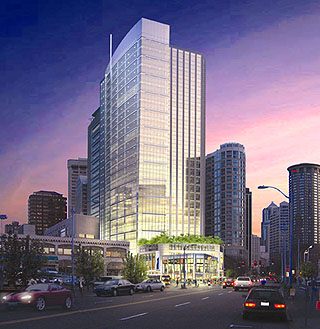
Surveys
DJC.COM
December 7, 2007
What’s next for Seattle’s CBD office market?
Touchstone Corp.

Howe
|
With that said, it has always been difficult to match commercial office supply with demand due to the long lead time it takes to acquire land and to design, permit and construct a major building project. Today, this process takes four to six years. Developers need to understand the real-estate cycle and anticipate future demand drivers for CBD office space.
Despite wishful thinking on the part of some developers who think this time will be any different, the 10-year economic cycle has been remarkably accurate and predictable. Office, as a real estate “food group,” peaks toward the middle to latter part of the cycle due to strong employment growth from employers catching up to meet industry demand that can no longer be satisfied with the existing workforce or from productivity gains.
Where are we today?

Image by Callison Architecture There is 1.9 million square feet of new office space coming to the Seattle CBD in 2008-09, including Touchstone’s West 8th project with 520,000 square feet. |
In the past two real estate development cycles, Seattle CBD vacancy rates dipped to their lowest levels in 1989 and 1999, and rental rates peaked in 1990 and 2000 before the office market went into a five-year decline as a result of oversupply. It appears that we are on track to repeat this cycle once again.
One of the best reports tracking the 10-year real-estate cycle is the annual Downtown Seattle Association CBD office market report authored by Anthony Gibbons. Although forecasts can never be perfect, Gibbons suggests in his 2007 report that, based on employment estimates, the CBD will need an additional 2.1 million square feet of space for the years 2007 through 2010.
In addition to the nearly 1 million-square-foot WaMu Center completed in 2006, a number of projects under construction will be delivered to the market in 2008 and 2009, totaling approximately 1.9 million square feet. These new office buildings include West 8th, at 520,000 square feet, 2201 Westlake (302,000), 7th & Madison (204,000), 818 Stewart (230,000) and 1918 8th Avenue (650,000). This suggests that in 2009 vacancy rates will be at a low point in the cycle and rental rates will still be rising.
However, another group of CBD office buildings with a high probability of commencing construction within the next 18 months would add 1.9 million square feet to the market in 2010 and 2011. These projects include the Coleman Center, at 173,000 square feet, Fifth & Yesler (260,000), 505 Madison (750,000) and 5th & Marion (700,000). Assuming all these projects are built and employment and demand forecasts are accurate, the best available data today suggests an office oversupply of 1.7 million square feet by 2011.
As the economy heads into a slow-growth phase — or even a recession with rising unemployment — the cycle will come full circle and repeat the painfully slow market absorption phase where vacancy rates are rising and rental rates are falling for another five years.
Another factor that could temper demand for new office buildings would be a major tenant leaving the Seattle CBD. It has been rumored that Amazon.com will vacate all of its downtown office space and relocate to a new campus in South Lake Union. This could add a sizable block of office space to the market in 2010 and 2011, exasperating what already appears to be an oversupply of space if all the announced buildings are built and delivered to the market.
Regardless of the market situation in terms of supply and demand for office space, what characteristics will give one building an advantage over its competition? Here are some industry trends that should be considered for future developments:
• Office building amenities. Important considerations for employers that are choosing where to locate will be whether buildings include on-site childcare; shared conference and meeting room facilities; ample food service and restaurant options in the building and nearby; game rooms; bicycle storage; exercise facilities and showers; inviting, comfortable, meeting-friendly lobbies; and outdoor landscaped spaces, decks and views.
• Green building. For the past several years, major employers and Fortune 500 companies have talked about the importance of sustainability in their workplace but will now start being held accountable on those promises. In this past year alone, landlords are seeing tenant RFPs asking about buildings’ sustainability and high-performance building systems, as well as landlords’ commitment to achieving LEED ratings. In most new commercial office buildings today, developers can achieve a LEED CS (core and shell) rating of silver or gold, with energy and water consumption savings resulting in lower operating expenses, if they organize their project team with clear objectives. Touchstone’s West 8th project under construction is the first commercial office building in Seattle to achieve a pre-certification rating of LEED gold CS, with an estimated 55 cents per square foot reduction in building operating expenses.
• Urban-focused developments. Projects must be well located with major transit, retail and housing options nearby for tenants and their employees. Giving them a variety of transportation choices (including mass-transit, Flexcar, light rail, trolley and pedestrian-based opportunities) increases the attractiveness of a building to tenants and provides employees with the feeling they’re part of a true 24-hour community.
• Building efficiency. Tenants will expect more from their office building in terms of efficient design and floor plates. Larger windows that allow more natural light and fresh-air exchange in the building systems promote a healthier and more productive work environment.
What’s in store?
Looking even farther down the road, the collaborative office work environment is alive and well. Technology will allow for more work options and more efficient use of space that will result in a moderate downward effect on the demand for new office space. However, offsetting this trend is the fact that existing office buildings will become functionally obsolete sooner than in the past. This will create demand for new buildings as older buildings are demolished or converted to residential or other uses.
Also, we can expect office rental asking rates to increase significantly due to higher building costs as a result of increased land prices, rising construction costs and regulatory mandates. There will likely be more deals completed on Class A space at the $50-plus per square foot rate, not to mention upper-level space that approaches $60 per square foot by 2009 and 2010.
In the biotech/research-and-development office market, the good news is that research institutions are strong and growing. Fred Hutchinson, PATH, ISB, Seattle Biomedical Research Institute and Children’s Hospital Research Institute, to name just a few, are all looking to expand based upon successfully attracting talent and continued funding by National Institutes of Health and private organizations such as the Gates Foundation.
A new generation of high-quality startups and a buoyant local venture capital industry also bodes well for future success and demand for R&D space. The bad news, in the short term, is the lackluster performance and lack of success by private biomedical companies in the early developmental stage. The expectation for Seattle is that this industry will become a strong employment driver and that Seattle will achieve recognition as a Tier 1 R&D market with a strong mix of research institutions, private companies and big pharmaceutical companies on par with San Francisco and Boston. However it may take another 10 years to achieve this promise.
Douglas Howe is president of Seattle-based Touchstone Corp., a private developer of regional commercial, technology and biotechnology R&D office, retail, hotel and mixed-use development projects. He serves as vice chair of the national board and executive committee of the National Association of Industrial and Office Properties, representing the commercial real estate development industry with more than 55 local chapters in the U.S. and Canada.
Other Stories:
- Commercial real estate continues its strength
- Retail evolves in mixed-use projects
- Use cost segregation to cut Uncle Sam’s bite
- Too many condos in Seattle? Think again
- An urban village emerges on Seattle’s First Hill
- Pros and cons of the Industrial Jobs Initiative
- Developing retail? Here are some things to know
- Downtown becomes too pricey for disabled homeless
- Workforce housing shortage is a ‘silent epidemic’
- Now is the time for apartments — but beware!
- Will good times continue for our market?
- Full speed ahead as CBA turns 30
- CBA Insights speaker profile: Dennis Wilde
- CBA Insights speaker profile: John Parker
- CBA Insights speaker profile: Linda Berman
- Hot Eastside office market won’t get red hot
Copyright ©2009 Seattle Daily Journal and DJC.COM.
Comments? Questions? Contact us.